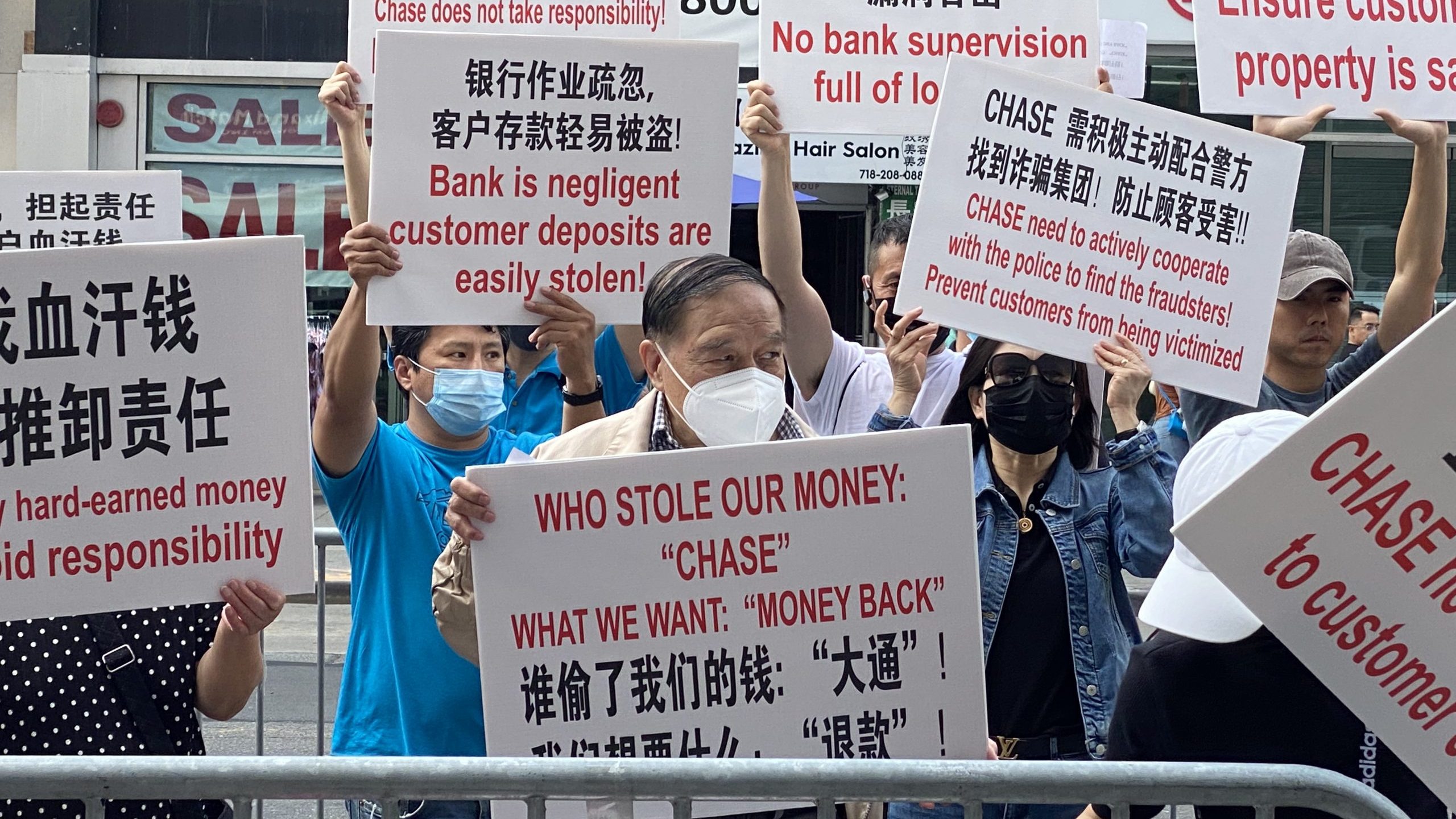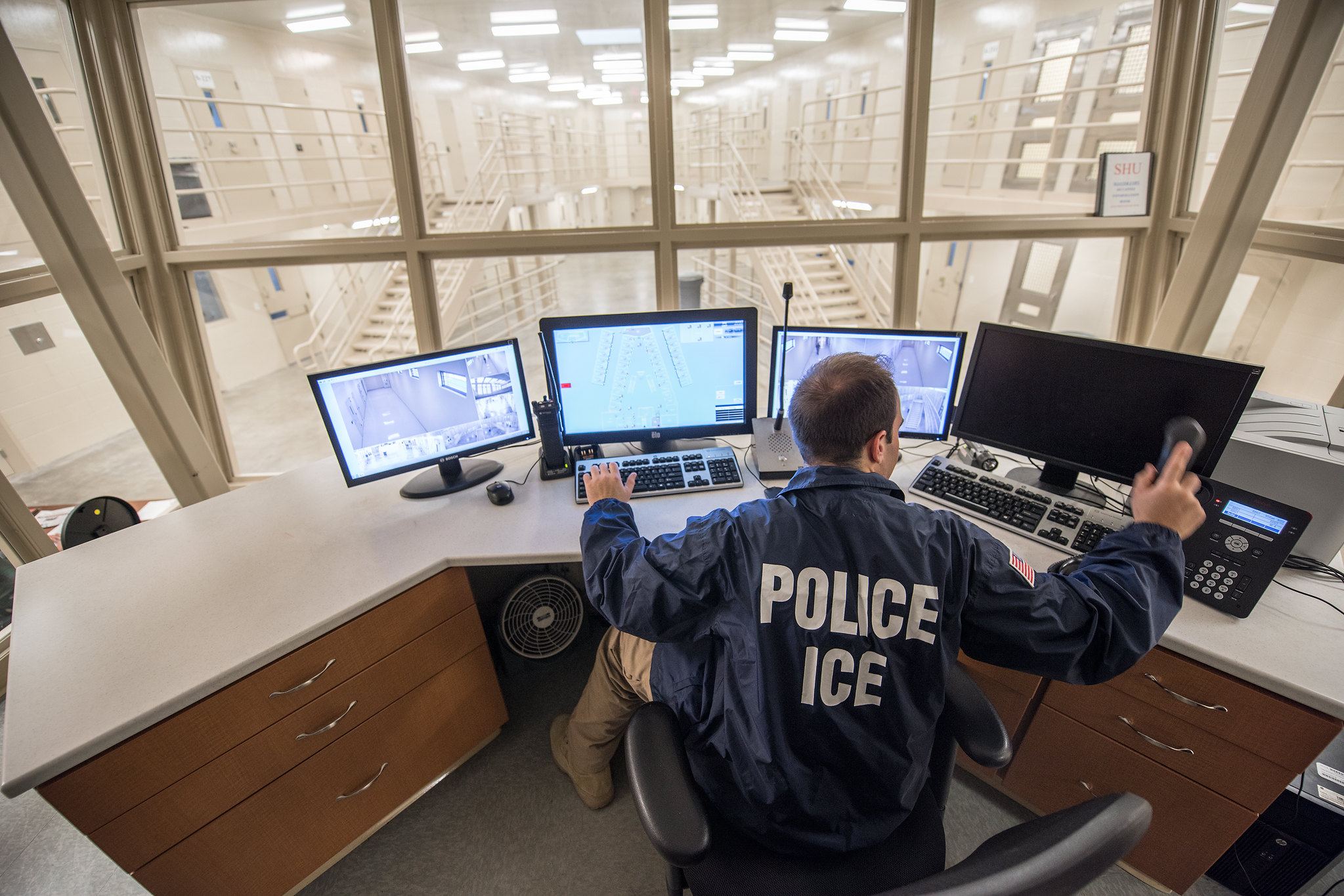Last November, a text popped up on Jack Zhang’s phone, notifying him his number would no longer receive any alerts regarding transactions made through his Chase bank account.
Zhang, 31, ignored the message at first, thinking it was a scam text. About a week later, Zhang found he could not log in to his online bank account. He called Chase immediately and was told to go to a local branch, where he was shocked to discover that $100,000 had already disappeared from his business account. Chase told Zhang that the money was withdrawn at four different Chase locations in Queens and the Bronx in $25,000 increments over four days in November 2021.
The loss was devastating to Zhang, who runs an after-school program in Queens that had been closed for almost two years during the pandemic. He said the $100,000 included a “life-saving” COVID disaster loan for small businesses.
“Now we cannot survive without the money,” he added.
Like other victims Documented spoke to for this article, Zhang preferred to use a pseudonym. He and others said they became more cautious after experiencing bank fraud, and worried that using their real names could put them at greater risk of identity theft.
“Please don’t mention my real name and the state I am currently in. I’m afraid more scammers will come after me when they see my information online and know that I have money in my account,” said a 40-year-old Chase customer who went by the name Hua Li, and reported $60,000 stolen from her account.
Zhang and Li are among dozens of Chinese customers who joined a recent letter-writing campaign against Chase, the largest bank in the U.S. They reported their money got stolen from their bank accounts through fraudulent transactions, and the bank didn’t provide them with the protection or support they needed.
Over 30 of them also attended a protest against Chase in May, holding bilingual signs in Chinese and English reading, “No bank supervision, full of loopholes!” They demanded the bank speed up the investigation of their claims, which have taken as long as seven months for some clients, and improve its security against identity theft.
The actions highlighted the prevalence of identity theft crimes in New York City, the loopholes in the financial security system, and insufficient support from big banks for clients, especially immigrants with language barriers and difficulty navigating the claim process.
A Tide of Identity Theft Hits The Chinese Community in NYC
According to a recent Federal Trade Commission report, New York’s rank for identity theft per capita among all states rose to 8 in 2021 from 22 a year prior.
“Identity theft has absolutely trended upwards and is continuing to do so during the pandemic,” said Chelsea Binns, Assistant Professor in the Department of Security, Fire & Emergency Management at John Jay College of Criminal Justice. She said the rise was due, in part, to the relaxation of protocols for unemployment benefits and the increase in online banking.
The Chinese identity theft victims were brought together by a WeChat group named “Bank Complainants Rights Protection Group,” founded by the Flushing Neighborhood Watch Team. This self-defense group sprung up in 2010 after the 23-year-old Chinese immigrant Yu Yao was raped and murdered in an alley.
Since Yao’s tragedy, over 1,600 people have volunteered at the FNWT, and the group has become an “aid station” for many Chinese-speaking immigrants, including Wen Chang, the first Chinese identity theft victim FNWT helped by recovering $36,000 from Chase in May.
Also Read: How to Protect Yourself From Identity Theft and Online Scams
As of July 1, the WeChat group consisted of 283 members. While the actual number of identity theft victims in the WeChat group is unknown, Michael Chu, the founder of FNWT, estimated that about half are identity theft victims, and the rest are community advocates and Chinese-language media reporters.
Chu pointed out the WeChat group members include clients of Chase, Bank of America and Citi, but about half of the victims are Chase customers. He explained that complaints against Chase dominate mainly because Chang’s story inspires more Chinese Chase customers to speak up.
Chang said in January, an unknown person applied for a new bank card under Chang’s name by impersonation and stole the $36,000 from his checking account via multiple withdrawals without his permission.
Lacking English proficiency, Chang asked his friend to help him translate the claim materials and sent the documentation to Chase. After an investigation, Chase rejected Chang’s claim, stating that he authorized the transactions.
FNWT became Chang’s last straw. Chu hosted a press conference telling Chang’s story. Chase apologized to Chang after being contacted by the media and promised to reimburse him.
Chu received “about 50 calls” from Chinese Chase bank clients with similar experiences within two weeks. Chu decided to build the WeChat group to better communicate with the victims.
Over the course of a month, over 20 Chase clients had their complaint letters translated into English with the help of FNWT. Chu said he started mailing the letters at the beginning of July to Chase and 12 different federal, state and city agencies, including Attorney General’s offices and Consumer Financial Protection Bureau.
Documented surveyed 15 members of the WeChat group who said they lost between $1,000 and $150,000 in unauthorized transactions. Most of those surveyed live in Chinese communities in Queens and Brooklyn, and six had opened their bank accounts at the Chase branch at 39-01 Main Street in Flushing.
Chase responded in an email regarding its instruction and support for identity theft victims, “It’s always important to quickly alert us to any transactions you don’t recognize. Also, because cases are different, our fraud team will tell a customer what information is needed for a specific claim.” said Chase Vice President of Regional Communications Briana Curran in a statement.
Chase didn’t respond directly to the questions about its process for investigating identity theft cases. “We review every customer situation we learn about,” Curran said in a statement. “Protecting customer’s accounts must be a partnership between the bank and the customer. We monitor accounts continually and need customers to do the same.” She suggested customers contact Chase as soon as possible once they found suspicious activity on an account and provided tips for fraud prevention.
Documented reviewed over 40 pages of documentation, including copies of driver’s licenses, bank statements, flight tickets and police reports provided by the protesters. The records showed that some Chase customers lived outside New York or were traveling in China when they said scammers stole their money from their bank accounts using fake passports or driver’s licenses.
An Arduous Claim Process
Zhang recovered part of his loss from Chase after attending the protest in May, but he said he would continue filing complaints against Chase, “I spent seven months dealing with the claim process. Can you imagine how much damage and impact it brought to a small business like us?”
Zhang said after he notified the bank that $100,000 was missing from his account last November, the bank told him to file a police report. However, after he visited the 112th police precinct, he was told to get an affidavit from the bank detailing the unauthorized transactions on his account.
Also Read: Excluded Workers Fund Hit With Debit Card Thefts
“Nobody at the bank told us the correct steps (of filing a claim). The bank is irresponsible for its clients!” said Zhang. He said it took him three times to successfully send his documentation to Chase’s Customer Claims Department, including faxing pages at a Chase branch office twice.
“When I called Chase asking about my case, they said they didn’t receive any fax,” Zhang said. “If it happened once, I can understand. But twice? How come?” Zhang said the bank finally received his documents after a bank staffer helped him email his files on his third try. Chase didn’t answer Documented’s question of how long investigations of identity theft normally take.
“Normally, the banks work very quickly, and mistakes will be resolved within a month,” said David Shapiro, Distinguished Lecturer and Coordinator of the Fraud Examination and Financial Forensics program at New York’s John Jay College of Criminal Justice. “I can’t speak as to what happened in that particular case,” Shapiro said, referring to Zhang’s case. “But that time frame is way out of the realm. That’s not a reasonably efficient and timely investigation date for November 2021,” he said.
For Chinese victims like Zhang, who made multiple trips between local bank branches and police stations to get the paperwork done, Shapiro said they might receive inaccurate directions to file claims communicated by the bank and police station. He pointed out that the information from the bank is “much more important” because the bank has the power to investigate more quickly and can resolve the situation.
Shapiro explained that a bank affidavit is helpful but not necessary for the police to file a report of fraud, “it helps in the sense that the essential details are all organized properly. But there is nothing to prevent an individual from going down to the police station expecting a report of a fraud.” Shapiro added.
Chase’s website listed steps for identity theft victims to resolve the issue. It directs identity theft victims to IdentityTheft.gov to find checklists and sample letters for recovery, notify the bank and credit reporting agencies. It also instructs them to file a report with local police, including the community where the identity theft took place and contact other government agencies.
Usually, bilingual staffers, if there are any, at Chase branches in Chinese communities would be able to provide services in Chinese. Chase didn’t answer whether it translates its identity theft protection kit into Chinese or offers any translation service for the customers in the Chinese community. Documented couldn’t find Chase’s identity theft policies in Chinese on its website.
As of July 7, at least eight members in the WeChat group reported Chase had contacted them, and their stolen funds were partially or fully returned. However, dozens of members in the group said they are still waiting.
Li, a customer of Chase for more than 10 years, said Chase told her that her missing $60,000 was wire transferred in person by someone using her New York driver’s license at the branch at 633 3rd Ave in Manhattan in June. Li said she moved out of New York seven years ago and stopped using her New York driver’s license. She said she asked Chase to make note of this on her account.
About a week later, an unknown person tried to make another wire transfer using Li’s driver’s license. Chase called Li to confirm the transaction, and Li denied it immediately. She told the bank that she had made notes about updated information on her driver’s license. “I asked them, why don’t you call the police? That person is a scammer!”
Chase told Li that the bank could not call the police. Curran confirmed the policy in a statement with Documented. “Customers should report suspected fraud to law enforcement, and Chase will cooperate with law enforcement requests.” Chase didn’t explain why the bank would not call the police.
Living outside New York, Li said she had to file a police report at a police station. She also made at least two trips to the Chase bank in Flushing, where she had initially opened her bank account and “spent hours calling Chase” to follow up with her claims.
Li said she felt “frustrated and angry” about how Chase responded to identity theft victims. “My money got stolen through the banking system, but it feels like the bank is passing the burden of investigation to the clients.”
Also Read: Scam Messages Are Targeting Immigrants On WhatsApp and Social Media
Chase told Chinese protesters that the bank would host workshops to educate its clients on better protecting their information. “No, you (Chase) should educate your employees on how to protect your clients better!” Zhang replied.
Chu said he noticed that many Chinese victims are targeted by Chinese scammers. Chu believed that some bank tellers may not be able to “tell the differences among Chinese” and would assume a Chinese person matches the photo on a stolen ID or fake ID.
Zhang said tellers at Chase branches didn’t double-check the identity of the scammer who took his money. “How could you let someone withdraw $25,000 so easily with a wrong signature?” What made him feel even worse was that “when this kind of scam happened, the bank didn’t take the initiative to solve the problem. Instead, it makes the clients feel it’s their own fault for having their money stolen,” Zhang added.
In response to Documented’s inquiry about the workshops, Curran said, “our community bankers are planning workshops (in fraud prevention), and we’ll share dates soon.”
Like many other victims, Li said now she is afraid of answering calls from unknown numbers. “I even thought a legit medical bill from a hospital might be a scam.” Several victims also told Documented that they now checked their bank accounts several times a day and could not sleep at night under the financial pressure and stress.
“It’s clear that there are many identity victims, who are also customers of three large banks (Chase, Bank of America, Citi) in particular,” said Queens Senator John Liu, who represents neighborhoods in Northeast Queens, including Flushing. Liu said his office had spoken with Chu and several other identity theft victims.
“People feel the banks are not providing them with sufficient customer support. The bank could be doing a better job and be more proactive in protecting their customers, especially when the customers are recent immigrants and have limited English proficiency,” Liu said in an interview with Documented. Chase didn’t respond to Liu’s statement.
Liu mentioned that his office had also contacted the NYPD about their procedures in taking police reports of identity thefts. “Identity theft is a big problem. It causes severe hardship not only financially but emotionally and otherwise,” he said. Liu urged people to be careful about their personal information and encouraged victims in need to contact his office.
Also Read: Victims of Excluded Workers Fund Fraud Owe Taxes for Money That Was Stolen From Them
“Depending on the facts of a case, an incident may be classified as Identity Theft, Grand Larceny, Petit Larceny, etc.,” a New York Police Department spokesperson replied in an email to Documented. NYPD said victims may call 911 or go to the nearest precinct or police facility to record a complaint report. “They are advised to bring or provide as much information or documentation that they have available.”
NYPD also pointed out that identity theft requires only a few pieces of valid personal information, such as name, address, date of birth, social security number and mother’s maiden name, to apply for and receive credit cards or debit cards in your name. NYPD suggests people take precautions, such as being more cautious about credit card safety and shredding cards or documents that contain important personal information.
Several victims told Documented they thought a bank was the safest place to deposit their hard earnings, but now they felt it was not secure anymore — one even considered buying a safe to keep his money. “Now I just lost my trust in banks, and I don’t know where is safe to put my money,” Li said, “I’m waiting for the investigation result from Chase every day. It’s like I’m waiting for a decision made by a judge.”















